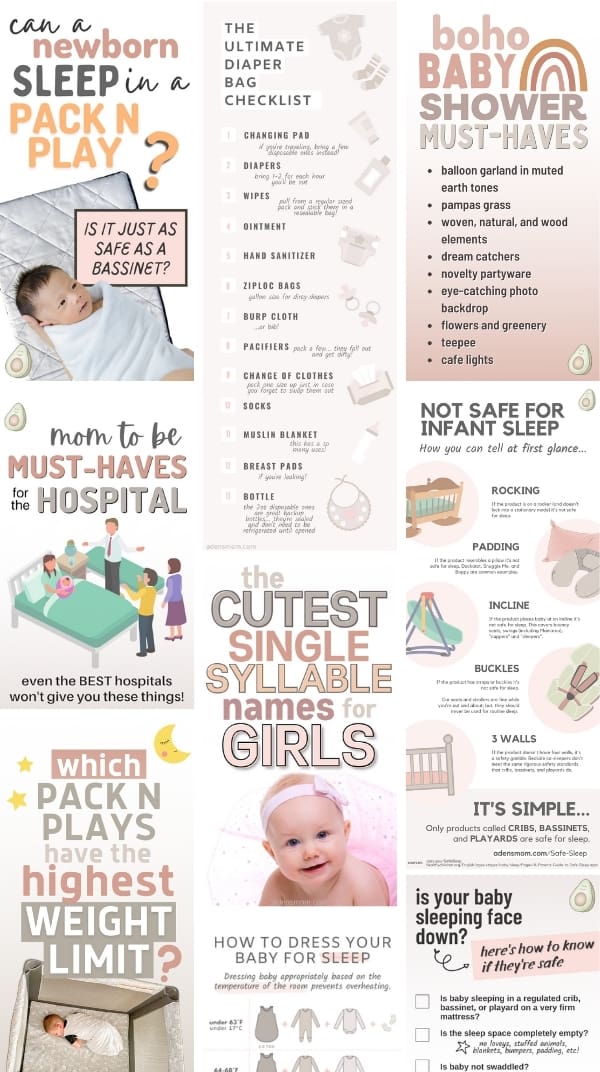Ahead: An evidence-based guide about when to stop swaddling and how to transition from swaddling.
Plus: when to worry and when it’s safe to relax.
If your baby is starting to roll, you’ve probably got lots of questions.
Are you supposed to stop swaddling?
If so, when?
And how?
Are certain swaddle transition products safer than others?
How are you ever going to get any sleep if your baby keeps rolling in the crib at night?
Do any of the safe sleep guidelines change now that the baby is mobile?
Should you be concerned if your baby’s face is pressed into the mattress?
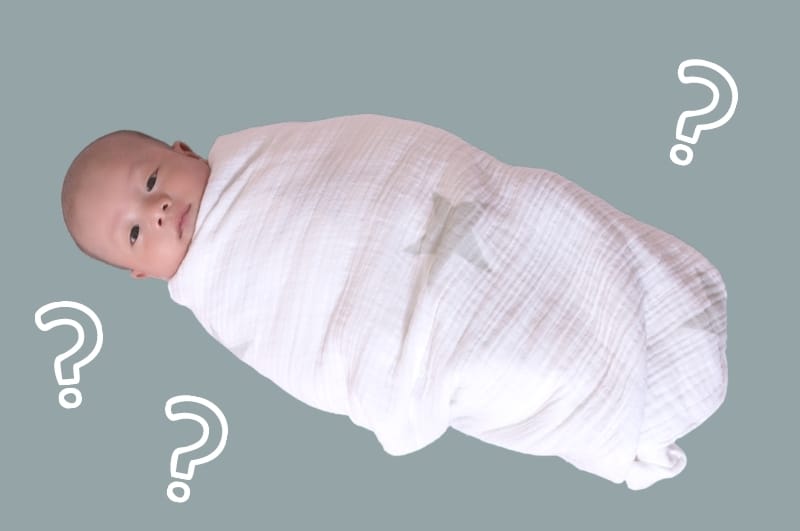
This guide is going to answer all of your questions.
And unlike the vast majority of others on the subject, this guide adheres strictly to AAP guidelines. It provides best practices based on scientific evidence, not personal anecdotes or opinions.
Here’s what we’re going to cover…
Table of Contents
SECTION 1: When, why, and how to stop swaddling
- When should you stop swaddling?
- What are the signs that a baby will roll over soon?
- Is it safe to swaddle a baby who can roll over?
- What are the risks of swaddling a baby who can roll over?
- What’s the proper alternative when it’s no longer safe to swaddle?
- Sleep sack vs. swaddle: what’s the difference?
- When should you transition from swaddling (and what does “transitioning” actually mean)?
- When should you stop swaddling cold turkey (no transition)?
- Quick recap
SECTION 2: Dealing with challenges
- What to do when your baby won’t sleep without the swaddle
- What to do when your baby is rolling over in the crib and waking up crying
SECTION 3: Common concerns about babies sleeping on their bellies
- Do you need to flip baby onto his back every time he rolls onto his stomach?
- Should you be worried if your baby is sleeping face down?
SECTION 4: FAQs + Summary
There may be affiliate links in this post. Read this disclosure policy to learn more.
PIN FOR LATER
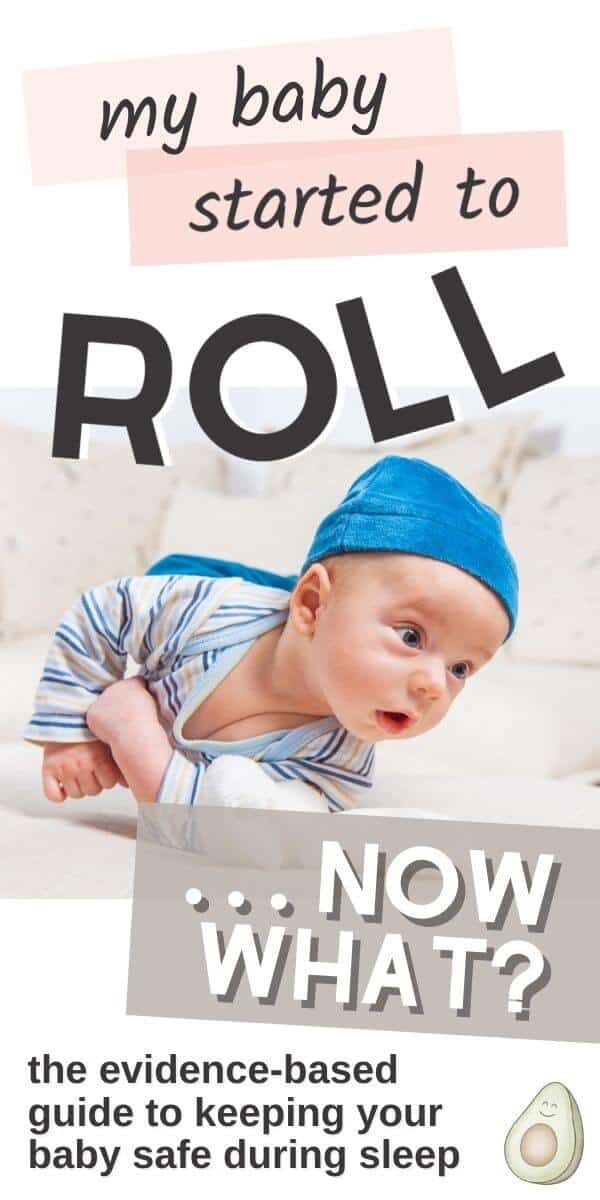
Section 1: When, why, and how to stop swaddling
I. When do you stop swaddling a baby?
According to current AAP guidelines:
“Parents should stop swaddling as soon as their baby shows any signs of trying to roll over. Many babies start working on rolling at around 2 months of age.”
(We’ll talk about the aforementioned signs of trying to roll in just a moment).
Some babies show signs of rolling even before 2 months, as early as just a few weeks old.
It’s hard to imagine a teeny tiny newborn making intentional efforts to roll over, but it happens all the time!
Babies often roll for the first time when parents least expect it.
If this happens while the baby is swaddled there is a substantial increase in the risk of SIDS/SUID.
This is why the AAP’s SIDS Task Force chairperson, Dr. Rachel Moon, gives the following warning:
“Given that we see deaths from babies who are swaddled and end up on their stomachs by 2-2½ months, I get really nervous when babies are swaddled past the age of 8 weeks.”
Since babies are increasingly likely to roll as they approach 2 months old, caregivers are advised to proactively stop swaddling to reduce the risk of SIDS.
Note: If your 2-month old isn’t rolling yet, don’t be alarmed.
The CDC considers rolling from tummy to back to be a 4-month milestone and rolling over in both directions to be a 6-month milestone.
II. What are the signs that a baby will roll over soon?
The beginning stages of learning to roll may look different for every baby.
Be on the lookout for any type of intentional (non-reflexive) attempts your baby makes to turn onto his side.
Here are a few examples of signs of rolling:
- Arching his back and pushing his head back
- Raising legs in the air and swaying his hips
- Throwing both arms over to one side
- Pushing off a surface with his leg(s)
- Rocking back and forth to the side
If, while your baby is awake, he positions himself onto his side, it’s probably a sign that he’s getting close to rolling.
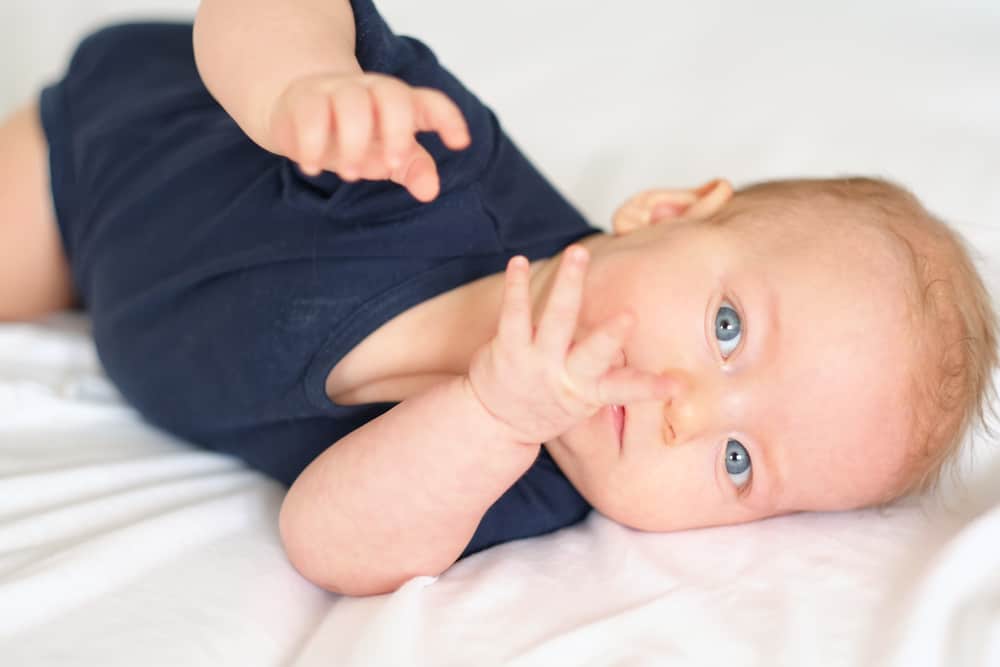
III. Is it safe to swaddle a baby who can roll over?
No, it is not safe to swaddle a baby who is rolling over or who is showing signs of rolling over.
Simply put, according to the AAP, there is a high risk of death if a swaddled infant rolls onto his belly.
In a moment, we’ll talk about the safest wearable blankets once your baby is able to roll.
But first, let’s talk about why it becomes unsafe to swaddle.
IV. What are the risks of swaddling a baby who can roll over?
It’s very tempting to continue swaddling past signs of rolling.
Chances are, your baby needs the swaddle to sleep, so taking it away sounds like a nightmare.
Understanding the dangers of swaddling after a baby rolls over may help you resist the temptation.
Here are the two main risks…
Risk #1: Suffocation
If a baby’s arms are inside a swaddle, he may not be able to reposition himself if he’s not getting enough oxygen.
This is especially dangerous if the infant is positioned on his side or stomach.
Risk #2: Reduced hypoxic arousal response
The tightness of the swaddle dampens the mechanism that allows a baby to wake up if he’s having trouble breathing.
Dr. Rachel Moon, the AAP’s chair of the Task Force on SIDS, explains:
“That is why parents like swaddling – the baby sleeps longer and doesn’t wake up as easily…
…but we know that decreased arousal can be a problem and may be one of the main reasons that babies die of SIDS.”
This is why it’s not safe to swaddle a baby who may be likely to roll over, even if the baby hasn’t fully rolled yet.
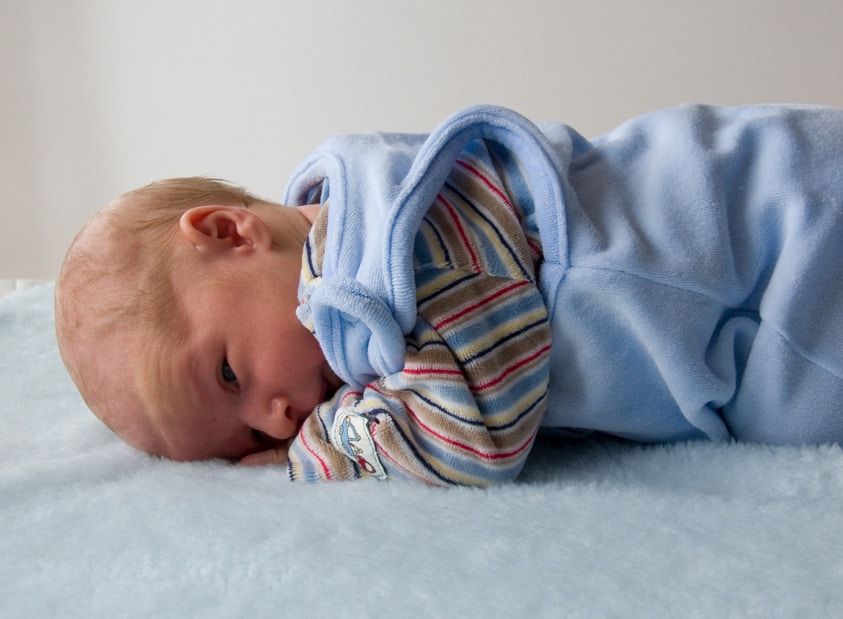
V. What’s the proper alternative when it’s no longer safe to swaddle?
Once your baby has started rolling over, you can switch to a sleep sack.
(We’ll talk about how this is different from a swaddle in just a moment.)
ADEN IN HIS AVOCADO SLEEP SACK
A sleep sack is a wearable blanket that keeps your baby warm during sleep without the risk of loose bedding.
(Actual blankets are unsafe for babies until they are at least 12 months old. Loose bedding significantly increases the risk of SIDS.)
VI. Sleep sack vs swaddle: what’s the difference?
This chart explains the key differences between sleep sacks and swaddles.
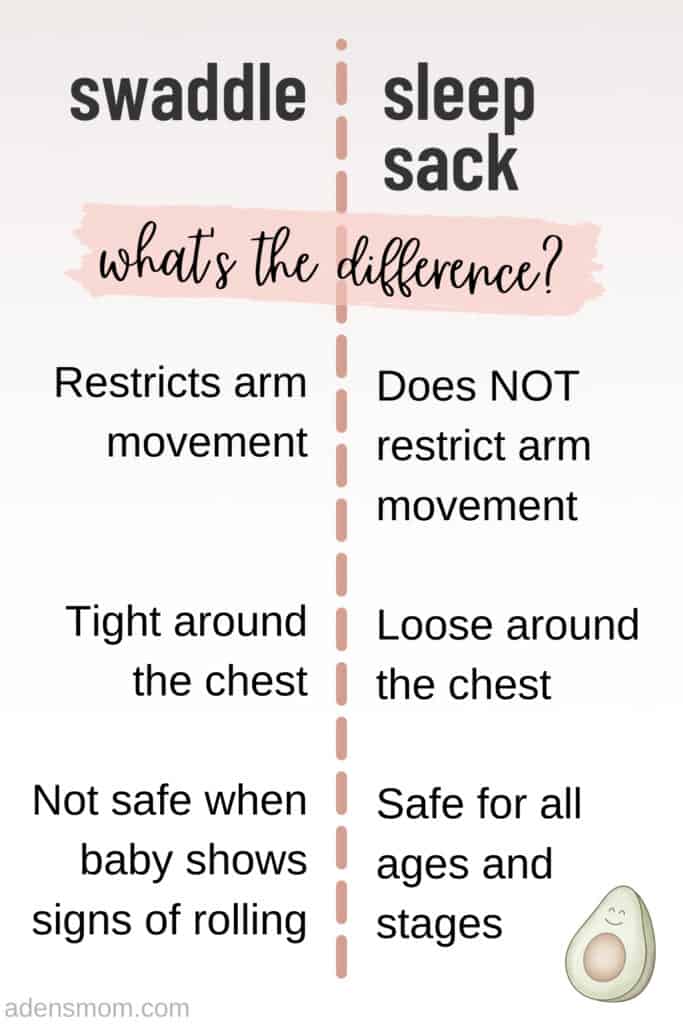
Unlike swaddles, sleep sacks do not compress the body or limit a baby’s range of motion.
This is why sleep sacks are safe for babies who can roll over.
Sleep sacks are safe for any age or developmental stage, rolling or not. They’re even great for newborns and toddlers!
It’s worth noting that while most sleep sacks are safe, there are two important caveats that you can read about in the FAQs.
Next, we’re going to talk about whether to stop swaddling gradually or drop the swaddle altogether.
VII. When should you transition from swaddling — and what does “transitioning” actually mean?
Transitioning from swaddling is not the same thing as dropping the swaddle.
The difference is important.
When we talk about transitioning from swaddling, we are referring to some type of gradual method that helps a baby adjust to not having the cozy feeling of compression.
Accordingly, “swaddle transition products” are typically some type of swaddle/sleep sack hybrid.
These products either contain the baby’s arms (often with more flexibility than a regular swaddle) or simulate the feeling of compression. Or both.
What many parents don’t realize…
Caregivers are often surprised to learn that (most) swaddle transition products are meant to be used BEFORE their baby starts showing signs of rolling.
In fact, once a baby is rolling—with the exception of one swaddle transition product that we’ll talk more about later—it is unsafe to go from a swaddle to a sleep sack in any type of gradual way.
“Transitioning” out of swaddling (i.e. gradual weaning) is only appropriate for babies who
- are less than 8 weeks old; and
- have shown no signs of rolling
If your baby meets these criteria, let’s talk about how to transition from swaddling…
If your baby doesn’t meet these criteria, skip to the next section.
Swaddle Transition Tips:
- Don’t swaddle for every sleep. For example, try only swaddling at night and using a sleep sack for naps.
- Try a sleep sack with wings. Secure the wings around the baby’s mid-section, leaving his arms free.
- Swaddle with one arm out. Consider a convertible swaddle that allows you to zip off one or both of the wings.
Again, the aforementioned options are swaddle alternatives and swaddle transitions for babies who have not begun to roll.
Now, let’s talk about what to use once your baby can roll.
VIII. Stopping swaddling cold turkey (no transition)
Typically, parents first start to think about weaning from the swaddle AFTER their baby has shown signs of rolling over.
When this is the case, it’s necessary to stop swaddling without any of the gradual transition methods listed above.
Will this be difficult?
You bet.
After all, for every sleep of your baby’s life, he’s probably been held or swaddled.
This is a big change, and chances are, everyone will sleep poorly at first.
That said, once a baby is able to roll, there isn’t the luxury of transitioning from swaddling gradually.
Remember, any form of swaddling once a baby can roll greatly increases the risk of suffocation.
In the next section, we’ll talk about how to survive this difficult phase.
But first, let’s take a look at the 2 safest swaddle replacements for babies that can roll over.
Option 1: Sleep sack
The safest option is to switch to a sleep sack, ensuring that (a) there is no compression or weight on the baby’s body and (b) that both of baby’s arms can move freely.
Option 2: Zipadee Zip
(Often misspelled Zippity Zip, Zipity Zip, Zippadee Zip, Zippidy Zip, Zipadeezip, and ZippadeeZip).
The Zipadee Zip is a swaddle transition product that’s probably safe for babies that are rolling over.
Out of all of the swaddle transition products, it’s your safest bet.
The reason we can’t say that it’s “definitely” safe is that the Zipadee Zip contains a baby’s arms, which gives it some of the properties of a swaddle.
That said, the Zipadee Zip sack is very loose (assuming you’re using the correct size).
Since a baby’s arms are able to move freely and there is zero compression around the chest, most experts agree that the risks of using a Zipadee Zip are low.
It’s worth noting that it’s ONLY safe to use a Zipadee Zip for babies who ARE rolling.
Do not use a Zipadee Zip for a baby who is unable to roll over.
If you decide you want to use a Zipadee-Zip, make sure to follow all manufacturer guidelines, which include the following:
* Baby can roll over
* Baby weighs at least 12 lbs
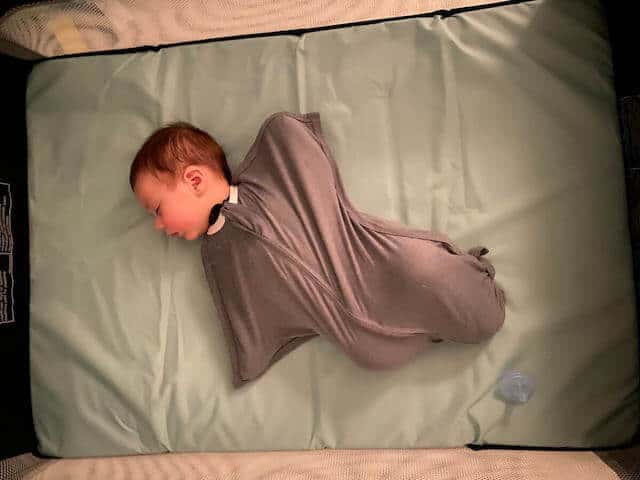
Here is Aden sleeping in his Zipadee Zip. You can read my Zipadee Zip review in the FAQs (at the end of this post).
What about the other swaddle transition products on the market?
Neither of the 2 other popular swaddle transition products are safe for babies who can roll.
We’ll discuss them briefly here, but if you’d like to learn more about their risks, click on the links below.
- Nested Bean Zen Sack. Weighted garments may reduce an infant’s ability to wake themselves up or reposition themselves if they’re having trouble breathing. Read this detailed article: Are Nested Bean Sleep Sacks Safe?
- Baby Merlin’s Magic Sleepsuit. In short, the sleepsuit is not safe for babies who can roll over. It also poses a risk of overheating, reduced arousal response, and suffocation due to the inability to reposition. Read this detailed article: Baby Merlin’s Magic Sleepsuit: Is it Safe?
Related: Are Dreamland Baby’s Weighted Sleep Sacks Safe?

VII. Recap
This concludes the first part of this swaddle transition guide.
In the next section we’re going to talk about common rolling-related challenges as well as safety questions about a baby sleeping face down.
But first, let’s recap the most important takeaways thus far:
 Parents should stop swaddling upon the first sign of their baby being able to roll.
Parents should stop swaddling upon the first sign of their baby being able to roll.
 Many experts err on the side of caution, instructing caregivers to stop swaddling by 8 weeks, even if the baby hasn’t shown signs of rolling yet.
Many experts err on the side of caution, instructing caregivers to stop swaddling by 8 weeks, even if the baby hasn’t shown signs of rolling yet.
 Swaddling a baby who can roll over (or may be likely to roll over) substantially increases the chance of sleep-related death.
Swaddling a baby who can roll over (or may be likely to roll over) substantially increases the chance of sleep-related death.
 To replace the swaddle, parents can switch to a sleep sack. Sleep sacks do not compress the body or limit a baby’s range of motion.
To replace the swaddle, parents can switch to a sleep sack. Sleep sacks do not compress the body or limit a baby’s range of motion.
 A gradual swaddle transition (such as one arm out of the swaddle) isn’t safe if the baby has already shown signs of rolling. Stopping all forms of swaddling cold turkey is the only safe option.
A gradual swaddle transition (such as one arm out of the swaddle) isn’t safe if the baby has already shown signs of rolling. Stopping all forms of swaddling cold turkey is the only safe option.
 The Zipadee Zip is the only swaddle transition product that is (probably) safe to be used for a baby who can roll over. Nested Bean and Magic Merlin should not be used.
The Zipadee Zip is the only swaddle transition product that is (probably) safe to be used for a baby who can roll over. Nested Bean and Magic Merlin should not be used.
Section 2: Dealing with challenges
X. What to do when your baby won’t sleep without the swaddle
Stopping swaddling is, of course, much easier said than done.
In fact, it’s notoriously difficult when babies start rolling over in the crib—and not just because they’re learning to sleep for the first time with their arms free.
Once your baby starts rolling, he’s going to want to practice rolling… in the middle of the night… while you’re desperately trying to sleep.
And often, he will get ‘stuck’ and not be able to move back to his preferred sleeping position.
All of the crying and sleep disruptions will have you wishing for a quick solution.
The good news and the bad news…
The bad news is that this adjustment period is going to take a lot of patience.
You’ve got a few long nights (and deliriously exhausted days) ahead of you, in all likelihood.
As much as you don’t want to hear this, consistency is the only actual solution to getting your baby to sleep without being swaddled.
But there is good news:
The first piece of good news is that with a consistent bedtime routine, this phase will not last long.
It often takes just a couple of nights for babies to adjust to not being swaddled.
The second piece of good news is that in addition to just staying the course, there are a few things you can do to help your baby sleep without the swaddle.
Here are some great tips…
How to get baby to sleep without swaddle
- Use your hands to apply light pressure to your baby’s arms for a few minutes after you put him down.
- Make sure the room is pitch black. Either invest in blackout curtains or tape tin foil to the windows.
- Turn on loud white noise. (See my favorite sound machine here). This is comforting to a baby because it mimics the sound of the womb.
- Always give your baby a chance to settle on his own before picking him up. Often, it only takes a couple of minutes.
- Consider the Zipadee Zip if your baby is able to roll and is 12+ pounds.
It’s going to feel like this phase is lasting forever, but hang in there. Your baby WILL make the adjustment, and it might only take a few nights.
XI. What to do when your baby is rolling over in the crib and waking up crying
It’s common for babies to wake from sleep after rolling over in the crib, especially if they don’t know how to roll back (or are new to rolling in general).
Always give your baby a chance to fall back asleep on his own before picking him up, especially if he’s just fussing or vocalizing.
Sometimes, all it will take is a minute or two for him to settle.
If whining devolves into a full blown cry and you decide you’re ready to step in, start with the least ‘invasive’ soothing technique, and increase only as needed:
Soothing ladder for a newly rolling baby
Step 1: Go into your baby’s room. Your presence alone might help him calm down.
Step 2: If this doesn’t work, try shushing, singing, or talking to your baby.
Step 3: If that fails, offer him a pacifier. (At this point, you might want to quickly flip him back over).
Step 4: If he’s still crying, try rubbing his belly or stroking his head.
Step 5: If steps 1 through 4 don’t work, pick him up. Try to soothe him without offering the breast or a bottle.
Step 6: If baby is still crying, feed him.
Alternatively, if your baby is older than 4 months and you’ve received pediatrician approval to sleep train, you can repeat your sleep training method of choice each time the baby rolls over in the crib and wakes up crying.
Related: Baby bumping head on crib (safe solutions that don’t involve bumpers)
Section 3: Common concerns about baby sleeping on belly
XII. Do you need to flip baby onto his back every time he rolls onto his stomach?
Good news:
From a safety perspective, it’s not necessary to return your baby to his back when he rolls onto his stomach in the crib, even if he’s sleeping face down.
According to the NIH, “When infants roll over on their own, there is no evidence that they need to be repositioned.”
The CPSC concurs:
“Once your baby rolls over onto his or her tummy, it’s okay to leave your baby there. Babies who can flip over can also turn their heads, a key developmental milestone that reduces the risk of suffocation.”
It’s critical to note, however, that all of this assumes that your baby is in a safe sleep environment. We’ll talk about this next.
XIII. Should you be worried if your baby is sleeping face down?
If you’ve taken the proper safety precautions, you do NOT need to worry if your baby has face-planted into the mattress.
(The same goes for a baby sleeping on his side—or any position for that matter).
Let’s take a look at those precautions:
1) You’re using a regulated crib and crib mattress that meet safety standards.
Cribs are federally regulated and undergo rigorous safety testing to ensure that no matter what position a baby takes, he can still breathe.
As long as your crib mattress is extremely firm and fits perfectly in the crib without any gaps, you can set your mind at ease.
Note: Memory foam mattresses are NOT standard crib mattresses and are unsafe. They are a serious hazard if your baby is sleeping face down.
2) The crib is free from suffocation and strangulation hazards.
All bets are off if anything is added to the crib besides a fitted sheet (and an optional mattress pad underneath).
It’s never safe to add any sort of padding or blankets to your baby’s crib, but it’s especially dangerous if your baby positions himself onto his side or stomach.
(And no matter what anyone tells you, there’s no such thing as a breathable lovey).
3) Baby isn’t swaddled.
If your baby is sleeping face down, face planted into the mattress, it is CRITICAL that he’s not sleeping in any sort of swaddle, weighted blanket, or ‘magic suit’.
Not only does he need free range of motion of his arms and legs, but he also needs to be able to easily wake from sleep if he’s having trouble breathing.
(As explained earlier, any product that compresses a baby’s chest or arms decreases infant arousal).
4) Baby was placed on his back.
If your baby is sleeping with his face pressed into the mattress, it’s okay to leave him, as long as he got there himself.
Important: Always start your baby off on his back, even if you’re confident that he’ll end up rolling onto his belly.
As long as you are taking the 4 precautions listed above, you don’t need to worry when your baby is sleeping on his stomach, even if he’s face down. You don’t need to reposition him or stay awake all night to supervise.
Pin or save this graphic for later:
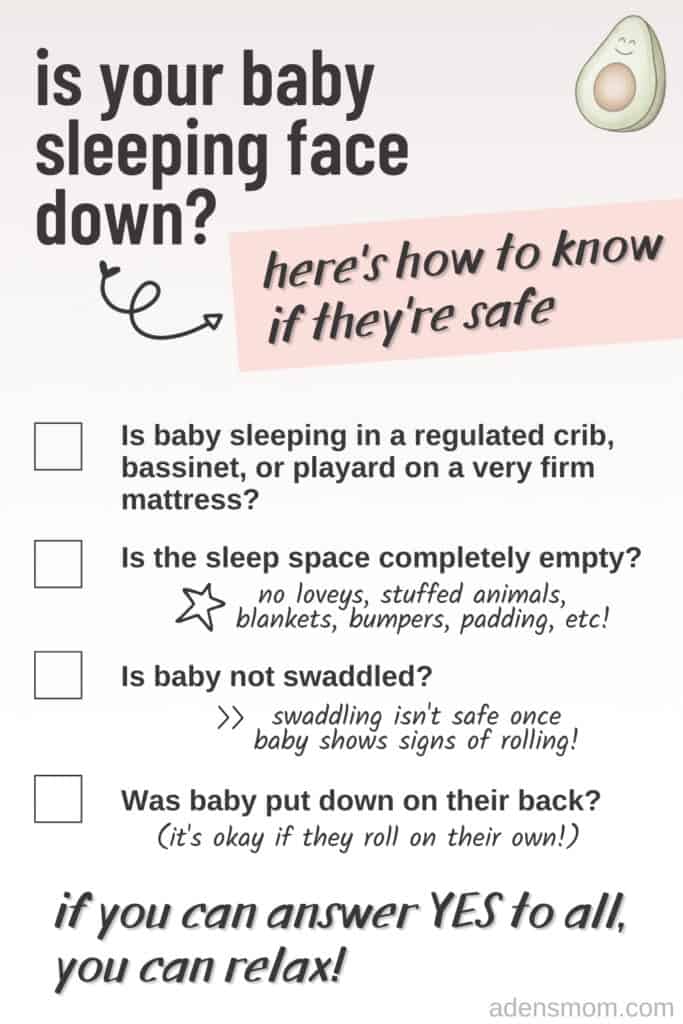
Section 4: FAQs + Summary
XIV. Frequently Asked Questions (FAQs) about about babies rolling over and transitioning from swaddling
Are the positive Zipadee Zip reviews accurate?
If you’ve been reading all of the Zipadee Zip reviews (often misspelled Zippity Zip), you’re probably wondering if all of the claims about it being a miracle product are true.
After all, this product isn’t cheap.
Having used it for Aden, here’s my Zipadee Zip review:
I’ll start with what you’re probably most curious about—did it help my baby sleep?
The answer: yes and no.
I know you wanted a concrete answer, but for us, there wasn’t one.
In general, Aden was NOT a good sleeper as a young baby (until we did some light sleep training at 4 months, which was an absolute game changer).
He woke every 2-3 hours, swaddle or no swaddle.
The Zipadee Zip sleep sack (unfortunately) didn’t change this—but I didn’t expect it to.
However, here’s where the Zipadee sack DID help:
It helped with putting him down and not having his startle reflex immediately wake him up. Those flailing baby arms, my gosh.
So the real benefit for us was that we had more success placing him in his crib.
Once we received pediatrician approval to do some light sleep training (we did a modified version of Ferber) when he turned 4 months, he immediately started sleeping much longer stretches and did really well with the Zipadee Zip at that point.
Do I think this product is overpriced?
Yes. I do. There’s nothing fancy about the fabric to make it almost 40 bucks.
That said, it’s the only swaddle transition product on the market that’s (probably) safe. So take my money.
This alone makes it the best swaddling transition sleep sack in my book.
If you read the Zipadee Zip reviews online from other parents, you’ll see a mixed bag: some people saying it didn’t work at all; and others saying it got their babies sleeping through the night.
My advice would be to set your expectations somewhere in the middle.
If your baby is already a lousy sleeper, this product ISN’T going to fix that. I mean, I guess it might, but it’s unlikely.
A reasonable goal would be for it to get you back to whatever baseline amount of sleep you were getting before you stopped swaddling.
Maybe, you’ll get lucky and it will do even more.
If that sounds worth it to you, then I’d give this product a try.
Click to see if there’s free 1-day shipping available in your area.
What if the Zipadee Zip doesn’t work and baby isn’t sleeping?
While the Zipadee Zip is a great product, its job isn’t to suppress your baby’s startle reflex. (That would make it unsafe for a rolling baby).
The Zipadee Zip only gently contains babies’ arms, which is in stark contrast to the tightness of a swaddle.
(Your baby has probably been used to this tightness his or her entire life, so this is going to take some getting used to).
After stopping swaddling, it’s typical for babies to wake themselves up and have trouble falling asleep, even with a Zipadee Zip.
The trick is to remain consistent and to not expect the Zipadee Zip to work magic overnight (no pun intended). You absolutely have to give it time.
Many babies adjust to sleeping without a swaddle within just a couple of nights, and often, the Zipadee-Zip makes this transition easier than a regular sleep sack does.
If the Zipadee Zip isn’t working for you yet, go back and read this earlier section: What to do when your baby won’t sleep without the swaddle.
Are sleep sacks safe for babies who can roll over?
As we discussed above in Section VI, sleep sacks are generally considered safe for babies who can roll over.
While most sleep sacks are safe, there are two important caveats:
Caveat Number 1:
Sleep sacks with “added” features or gimmicks are often unsafe.
(Just because the brand calls it a sleep sack, doesn’t mean it’s safe.)
In fact, many sleep sacks marketed to “help a baby sleep” or “ease the swaddle transition” may actually be quite unsafe, particularly when babies can roll.
A prime example is the Nested Bean sleep sack, a weighted product that may compromise an infant’s breathing and the ability to reposition himself when in danger.
WHICH SLEEP SACKS ARE SAFE (AND GIMMICK-FREE)?
Here are a few recommendations to get you started:
- This fleece one that turns your baby into an avocado, a strawberry, a penguin, or a caterpillar.
- This cult-favorite all season sleep sack that will fit from 2-24 months!
- This long-sleeved fleece one that’s great to have when your baby is wearing short sleeves.
Caveat Number 2:
Sleep sacks are only safe if they fit properly.
What matters most is the neck hole.
The neck hole should be small enough so that the fabric can’t ride up over a baby’s mouth.
(If the rest of the sleep sack is loose, it’s fine).
Typically, manufacturers provide size guidelines based on age, length, and weight. Be sure to follow these guidelines when choosing a sleep sack for your baby.
Even if you buy the proper size, use your best judgment about whether the neck hole looks too big.
And again: a sleep sack should not limit your baby’s range of motion or compress the chest.
My baby is rolling over at 2 months old, is this normal and what should I do?
Lots of babies start rolling over at 2 months of age, according to the AAP.
This is precisely why safe sleep experts urge parents to err on the side of caution and stop swaddling by 8 weeks, even if the baby doesn’t know how to roll yet.
If your baby can roll over at 2 months, be sure to stop swaddling entirely.
Unfortunately, there aren’t any swaddle transition products that are safe for a rolling 2-month old baby.
- A 2-month old baby is too young for the Zipadee Zip. (Baby should be at least 3 months old and weigh at least 12 lbs).
- Don’t use Baby Merlin’s Magic Sleepsuit as it’s not safe for babies who can roll over.
- Skip the Nested Bean Zen Sack as well. Weighted blankets dampen a baby’s life-saving mechanism of being able to wake easily from sleep if he isn’t getting enough oxygen.
If your baby is rolling over at 2 months old, switch to a regular sleep sack that doesn’t compress the baby’s chest or arms.
Read this related post: Safe Sleep 101
My baby is rolling over at 3 months old, is this typical and what should I do?
It’s absolutely within the range of normal for a 3-month old baby to be rolling over. (Typically, babies are rolling from back to tummy at 3 months, but not from tummy to back yet).
Here’s what the AAP has to say about rolling at 3 months old:
“As her kicks continue to become more forceful, she may soon be able to kick herself over from her tummy to back. While most babies can’t roll from back to tummy yet, some may begin rolling over at this age. Be careful never to leave your baby alone on furniture where they could roll over.”
If you haven’t already stopped swaddling at 2 months (as recommended), be sure to stop now that your baby can roll over.
The safest replacement for a swaddle is a sleep sack.
If your baby is rolling over at 3 months and you think it will be hard to drop the swaddle and go straight to a sleep sack, the best “transition” product is the Zipadee Zip.
While the Zipadee Zip falls into a gray area of safety, it’s a much better bet than other popular swaddle transition products (i.e. Baby Merlin’s Magic Sleepsuit and Nested Bean Zen Sack) which aren’t as safe.
To safely use the Zipadee Zip, make sure your rolling 3-month old is at least 12 pounds.
Is my baby rolling over too early?
Healthy infants start intentionally rolling as young as just a few weeks old, so your baby is probably not rolling over too early.
If your baby is rolling, it’s time to stop swaddling, even if he hasn’t reached 2 months old yet.
In extremely rare cases, rolling over too early can be an early sign of abnormal reflexes, which is a possible indicator of Cerebral Palsy. But, before you start panicking, keep in mind that normal infants roll at all different ages.
If you have any concerns that your baby is rolling over too early, bring this up with your pediatrician.
Do sleep sacks prevent rolling?
My baby is rolling over in his swaddle, is this safe?
No. It’s a serious suffocation risk to swaddle a baby who can roll over.
If your baby is rolling over in the swaddle, you should stop swaddling IMMEDIATELY.
Read the earlier sections of this post about the safety risks of swaddling a baby who can roll over and dropping the swaddle cold turkey.
Is there such a thing as a safe swaddle for a baby who rolls?
When should you stop using a sleep sack?
There’s no reason to stop using a sleep sack, unless you want to.
The AAP says:
“Sleep sacks that do not swaddle and allow the baby to move freely can be used indefinitely.”
So, go ahead and use that sleep sack all the way through toddlerhood and beyond! (Just make sure it fits properly).
How many sleep sacks should you buy in each size?
There is certainly no hard and fast rule about how many sleep sacks to buy in each size.
At a minimum, you’ll probably want to have 2 sleep sacks in each size in case one gets dirty.
I like to have a mix of lighter weight sleep sacks and warmer ones.
Should you try to keep baby from rolling over?
No. You don’t need to prevent baby from rolling over in the crib—nor should you.
Placing anything in the crib to try to keep your baby on his back is extremely dangerous. The same goes for any type of swaddle or sleep sack that purports to make it more difficult for your baby to roll.
Once a baby is physically capable of rolling (or is getting close), it’s safest to let him move about the sleep space as he wishes.
As long as your baby is not swaddled and is sleeping in an empty crib, bassinet, or playard, there is no need to stop baby from rolling over.
Be sure to always place your baby on his back for every sleep, even if you know he’s likely to roll onto his belly or side on his own.
Should you buy an “anti roll pillow”?
Do not use an infant anti roll sleep positioner.
The AAP, FDA, and CPSC have explicitly, in black and white terms, advised against the use of sleep positioners, no matter the type.
Under no conditions should a baby anti roll pillow be added to an infant’s sleep space. They are known suffocation hazards, entrapment risks, and are linked to numerous infant deaths.
Here’s a visualization from the FDA of what can go wrong by using an anti roll baby pillow or baby sleep positioner:
Do lots of stores sell baby anti roll pillows? You bet.
Unfortunately, that doesn’t mean they’re safe.
It’s also worth noting that there are no scientifically proven benefits of using a baby anti roll pillow or a sleep positioner.
XV. Final thoughts on keeping your baby safe during sleep once he starts rolling over
This isn’t an easy phase and it’s natural to feel anxious or frustrated, especially when you’re sleep deprived.
What’s most important is listening to the experts and following the evidence about keeping your sleeping baby safe.
After reading this post, you now know that:
- Sleep sacks are safe for babies who can roll over, but swaddles of any kind are not.
- A gradual transition from a swaddle to a sleep sack is only safe for a baby who has not yet shown signs of being able to roll over.
- It isn’t necessary to prevent baby from rolling over in the crib; it’s much safer for the crib to be bare.
- You don’t need to stress about your baby rolling over in sleep face down, as long as you’ve taken the proper safety precautions.
- Regardless of a baby’s age, it is NEVER safe to swaddle an infant that can roll over.
Share this post with a friend or family member!

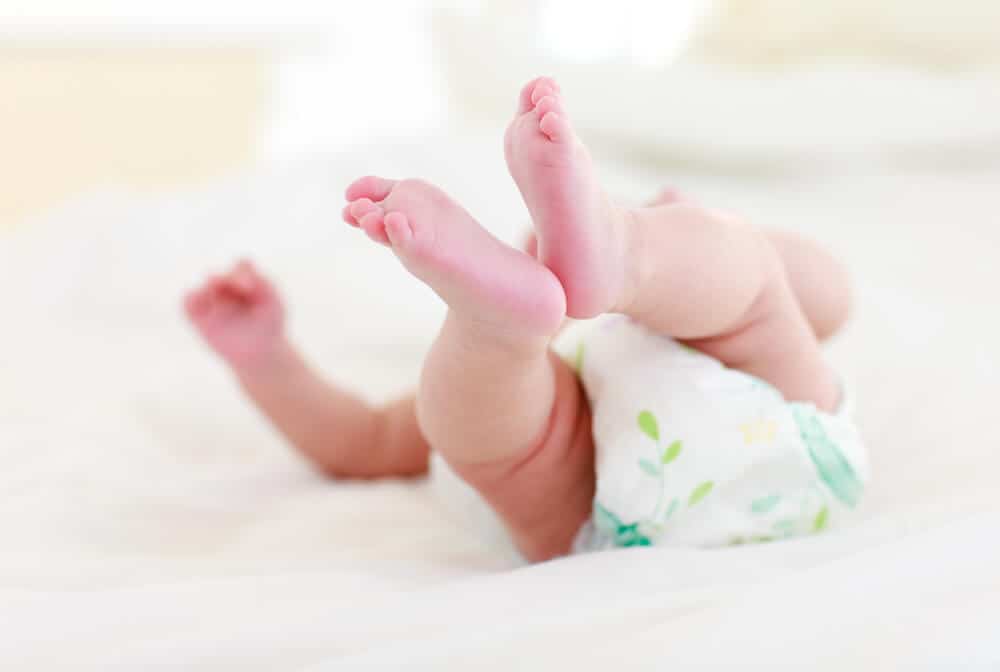






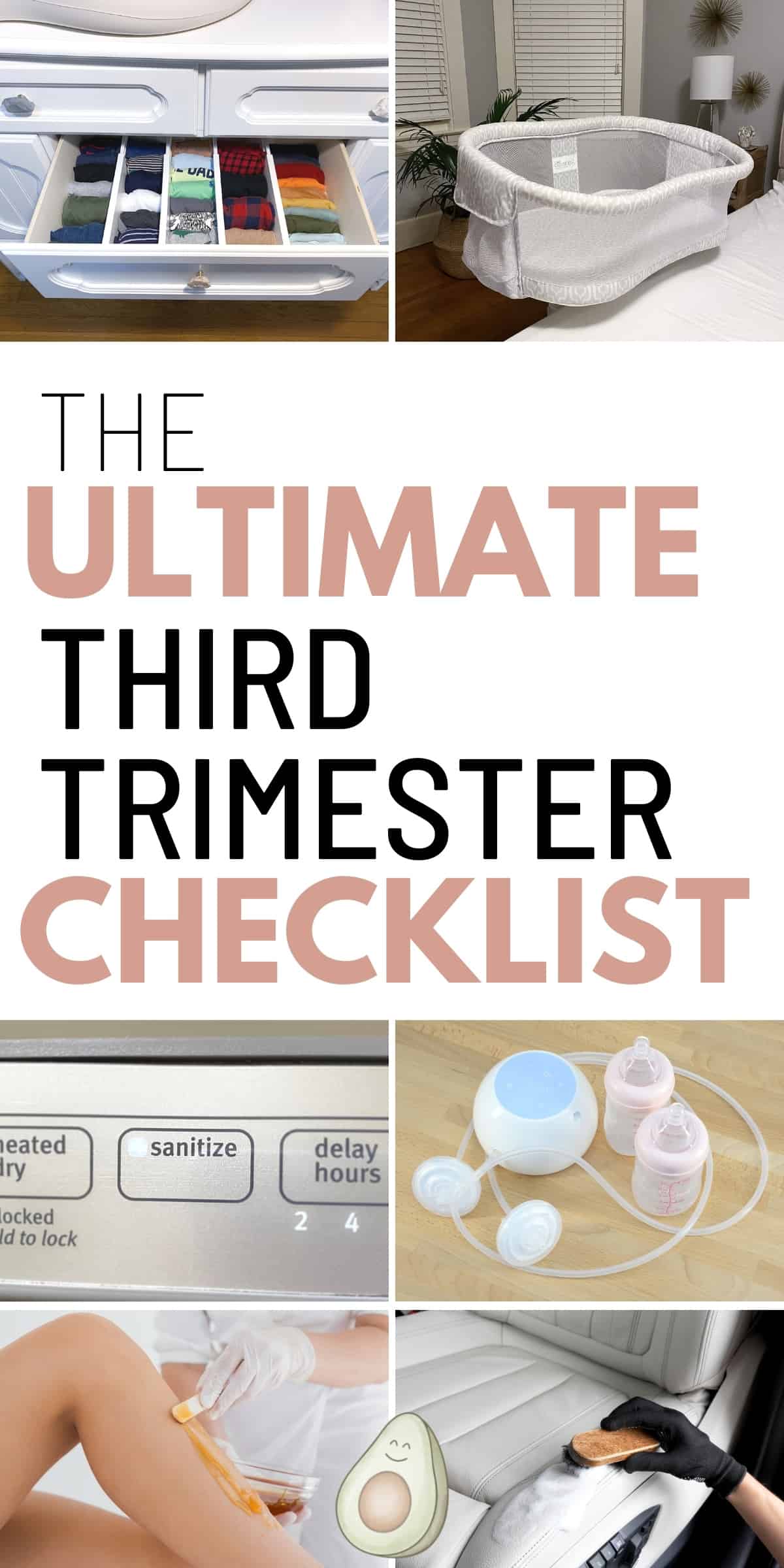
 Follow on Pinterest
Follow on Pinterest